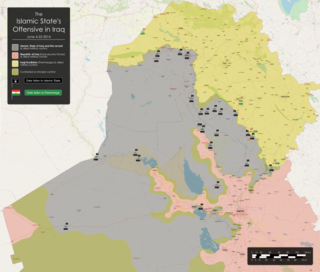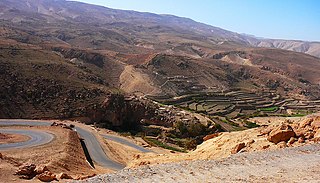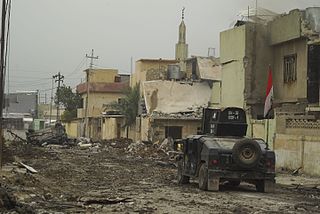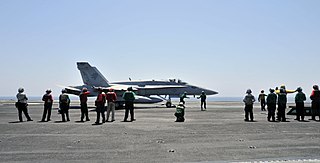Related Research Articles
A beheading video is a video which depicts a live murder in which a hostage or victim is shown to be graphically decapitated, or the head is displayed in the aftermath. Such videos are typically distributed mostly through the Internet, and are often employed by groups seeking to instill shock or terror into a population. Although beheading has been a widely employed public execution method since the ancient Greeks and Romans, videos of this type only began to arise in 2002 with the beheading of Daniel Pearl and the growth of the Internet in the Information Age, which allowed groups to anonymously publish these videos for public consumption. The beheadings shown in these videos are usually not performed in a "classical" method – decapitating a victim quickly with a blow from a sword or axe – but by the relatively slow and torturous process of slicing and sawing the victim's neck, while still alive, with a knife.

The Islamic State (IS), also known as the Islamic State of Iraq and the Levant (ISIL), the Islamic State of Iraq and Syria (ISIS) and by its Arabic acronym Daesh, is a transnational Salafi jihadist group and an unrecognised quasi-state. Its origins were in the Jai'sh al-Taifa al-Mansurah organization founded by Abu Omar al-Baghdadi in 2004, which fought alongside Tanzim Qaidat al-Jihad fi Bilad al-Rafidayn during the Iraqi insurgency. The group gained global prominence in 2014, when its militants successfully captured large territories in northwestern Iraq and eastern Syria, taking advantage of the ongoing Syrian civil war. It is well known for its massive human rights violations and war crimes. It engaged in the persecution of Christians and Shia Muslims, and published videos of beheadings and executions against journalists and aid workers. By the end of 2015, it was internationally considered to be one of the biggest terrorist organizations of all time and it ruled an area with an estimated population of twelve million people, where it enforced its extremist interpretation of Islamic law, managed an annual budget exceeding US$1 billion, and commanded more than 30,000 fighters.

The Islamic State of Iraq was a Salafi jihadist militant organization that fought the forces of the U.S.-led coalition during the Iraqi insurgency. The organization aimed to overthrow the Iraqi federal government and establish an Islamic state governed by Sharia law in Iraq.

The Northern Iraq offensive began on 4 June 2014, when the Islamic State of Iraq and Levant, assisted by various insurgent groups in the region, began a major offensive from its territory in Syria into Iraq against Iraqi and Kurdish forces, following earlier clashes that had begun in December 2013 involving guerillas.

The Sinjar massacre marked the beginning of the genocide of Yazidis by ISIL, the killing and abduction of thousands of Yazidi men, women and children. It took place in August 2014 in Sinjar city and Sinjar District in Iraq's Nineveh Governorate and was perpetrated by the Islamic State of Iraq and the Levant (ISIL). The massacre began with ISIL attacking and capturing Sinjar and neighboring towns on 3 August, during its Northern Iraq offensive.

The war in Iraq was an armed conflict between Iraq and its allies and the Islamic State. Following December 2013, the insurgency escalated into full-scale guerrilla warfare following clashes in the cities of Ramadi and Fallujah in parts of western Iraq, and culminated in the Islamic State offensive into Iraq in June 2014, which lead to the capture of the cities of Mosul, Tikrit and other cities in western and northern Iraq by the Islamic State. Between 4–9 June 2014, the city of Mosul was attacked and later fell; following this, Prime Minister Nuri al-Maliki called for a national state of emergency on 10 June. However, despite the security crisis, Iraq's parliament did not allow Maliki to declare a state of emergency; many legislators boycotted the session because they opposed expanding the prime minister's powers. Ali Ghaidan, a former military commander in Mosul, accused al-Maliki of being the one who issued the order to withdraw from the city of Mosul. At its height, ISIL held 56,000 square kilometers of Iraqi territory, containing 4.5 million citizens.

Many states began to intervene against the Islamic State, in both the Syrian Civil War and the War in Iraq (2013–2017), in response to its rapid territorial gains from its 2014 Northern Iraq offensives, universally condemned executions, human rights abuses and the fear of further spillovers of the Syrian Civil War. These efforts are called the war against the Islamic State, or the war against ISIS. In later years, there were also minor interventions by some states against IS-affiliated groups in Nigeria and Libya. All these efforts significantly degraded the Islamic State's capabilities by around 2019–2020. While moderate fighting continues in Syria, as of 2024, ISIS has been contained to a manageably small area and force capability.

On 22 September 2014, the United States officially intervened in the Syrian civil war with the stated aim of fighting the terrorist organization ISIS in support of the international war against it, code named Operation Inherent Resolve. The US currently continues to support the Syrian rebels and the Kurdish-led Syrian Democratic Forces opposed to both the Islamic State and Syrian president Bashar al-Assad.

Beginning in 2014, a number of people from various countries were beheaded by the Islamic State (IS), a radical Sunni Jihadist group operating in Iraq and Syria as well as elsewhere. In January 2014, a copy of an IS penal code surfaced describing the penalties it enforces in areas under its control, including multiple beheadings. Beheading videos have been frequently posted by IS members to social media. Several of the recorded beheadings were conducted by Mohammed Emwazi, whom the media referred to as "Jihadi John" before his identification. The beheadings received wide coverage around the world and attracted international condemnation. Political scientist Max Abrahms posited that IS may be using well-publicized beheadings as a means of differentiating itself from Al-Qaeda in Iraq, and identifying itself with Khalid Sheikh Mohammed, the al-Qaeda member who beheaded Daniel Pearl. The publicised beheadings represent a small proportion of a larger number of total people killed following capture by IS.

On 15 June 2014 U.S. President Barack Obama ordered United States forces to be dispatched in response to the Northern Iraq offensive of the Islamic State (IS), as part of Operation Inherent Resolve. At the invitation of the Iraqi government, American troops went to assess Iraqi forces and the threat posed by ISIL.

Abd al-Rahman Mustafa al-Qaduli, better known as Abu Ali al-Anbari, was the governor for territories held by the Islamic State of Iraq and the Levant (ISIL) in Syria. Considered the ISIL second-in-command, he was viewed as a potential successor of ISIL leader Abu Bakr al-Baghdadi.

The Military of the Islamic State is the fighting force of the Islamic State (IS). The total force size at its peak was estimated from tens of thousands to over two hundred thousand. IS's armed forces grew quickly during its territorial expansion in 2014. The IS military, including groups incorporated into it in 2014, openly operates and controls territory in multiple cities in Libya and Nigeria. In October 2016, it conquered the city of Qandala in Puntland, Somalia. It conquered much of eastern Syria and western Iraq in 2014, territory it lost finally only in 2019. It also has had border clashes with and made incursions into Lebanon, Iran, and Jordan. IS-linked groups operate in Algeria, Pakistan, the Philippines, and in West Africa. In January 2015, IS was also confirmed to have a military presence in Afghanistan and in Yemen.
The condition of human rights in the territory controlled by the Islamic State (IS) is considered to be among the worst in the world. The Islamic State's policies included acts of genocide, torture and slavery. The United Nations Commission on Human Rights (UNCHR) stated in November 2014 that the Islamic State "seeks to subjugate civilians under its control and dominate every aspect of their lives through terror, indoctrination, and the provision of services to those who obey". Many Islamic State actions of extreme criminality, terror, recruitment and other activities have been documented in the Middle East.
Executions by ISIS refers here to killing by beheading, immolation, shooting, or other means of soldiers and civilians by the Islamic State of Iraq and the Levant (ISIL). ISIL has released a number of propaganda/publicity videos of beheadings or shootings of captives. Houtat Sulūk is reported to be a mass grave.

The Timeline of the War in Iraq covers the War in Iraq, a war which erupted that lasted in Iraq from 2013 to 2017, during the first year of armed conflict.
The response of Saudi Arabia to the Islamic State has taken many forms. For example, Saudi government agencies have worked with the United States since late 2014 to train and equip Syrian fighters hoping to engage with Islamic State of Iraq and the Levant (ISIL) militants. The challenges of dealing with ISIL is complicated by the fact that around 2,500 militants originally from Saudi territory have left for Syria in order to join ISIL, the destabilization created by the Syrian Civil War having a big effect on the region.
The name of the Islamic State has been contentious since 2013. In Arabic, the group called itself al-Dawlah al-Islāmīyah fī al-`Irāq wa al-Shām, which it adopted in April 2013. The literal translation of its previous name resulted in confusion, resulting in both ISIS and ISIL, two acronyms based on different literal translations of the name into English. Apart from these, an Arabic-derived acronym, "Daesh", Da'ish or Dā`iš (داعش), is also a common name for the group beyond the Arabic-speaking parts of the world. Finally, the group's current name caused controversy due to its English translation as Islamic State and as a result, both the previous acronyms are still widely used, or a qualifier is often added to the IS name, such as "Islamic State militant group", "Islamic State extremist group", "Islamic State terrorist group", "self-styled Islamic State" or "so-called Islamic State".
In early 2014, the jihadist group Islamic State of Iraq and the Levant captured extensive territory in Western Iraq in the Anbar campaign, while counter-offensives against it were mounted in Syria. Raqqa in Syria became its headquarters. The Wall Street Journal estimated that eight million people lived under its control in the two countries.
Collaboration with the Islamic State refers to the cooperation and assistance given by governments, non-state actors, and private individuals to the Islamic State (IS) during the Syrian Civil War, Iraqi Civil War, and Libyan Civil War.
The origins of the Islamic State group can be traced back to three main organizations. Earliest of these was the "Jamāʻat al-Tawḥīd wa-al-Jihād" organization, founded by the Jihadist leader Abu Mus'ab al-Zarqawi in Jordan in 1999. The other two predecessor organizations emerged during the Iraqi insurgency against the U.S. occupation forces. These included the "Jaish al-Ta'ifa al-Mansurah" group founded by Abu Omar al-Baghdadi in 2004 and the "Jaysh Ahl al-Sunnah wa’l-Jama’ah" group founded by Abu Bakr al-Baghdadi and his associates in the same year.
References
- ↑ Menzel, Andrew. "Jordanian pilot 'burned alive' in new Isil video". Telegraph.cu.uk. The Telegraph. Retrieved 19 March 2015.
- ↑ Doblin, Alfred P. (22 October 2014). "We need Churchill, not a 21st century Chamberlain". The Record . Retrieved 1 December 2014.
- ↑ Hill, Liezel; Deveau, Scott; De Vynck, Gerrit (2014-10-23). "Canadians From Calgary to Timmins Heed Islamic State". Bloomberg. Retrieved 2014-12-09.
- ↑ Watson, Ivan; Tuysuz, Gul; Ford, Dana (2014-10-27). "'At peace' in war: A former U.S. soldier battles ISIS". CNN. Retrieved 2014-12-01.
- ↑ Kaye, Randi (2014-10-24). "Canada travel ad or pro-ISIS video?". CNN. Retrieved 2014-12-01.
- ↑ Sadik, Odai; Carter, Chelsea J.; Leopold, Todd (2 November 2014). "Public executions and mass graves: ISIS targets Sunni tribe in Iraq". CNN. Retrieved 1 December 2014.
- ↑ Defterios, John (3 September 2014). "ISIS' struggle to control its oil riches". CNN.com. CNN. Retrieved 19 March 2015.
- ↑ CBS This Morning. "New details emerge on Kayla Mueller's ISIS captivity". cbsnews.com. CBS News. Retrieved 19 March 2015.
- ↑ Eckhardt, Andy. "Number of Women From West Becoming Jihadi Brides Rises: German Official". NBCNews.com. NBC News. Retrieved 19 March 2015.
- ↑ Yacouc, Sameer N. (8 November 2014). "US airstrikes target Islamic State leaders in Iraq". Associated Press . Retrieved 1 December 2014.
- ↑ Pearson, Michael (9 November 2014). "ISIS fight in new phase, Obama says". CNN. Retrieved 1 December 2014.
- ↑ "No Debate and the New War: Study finds little opposition to US attacks on Iraq, Syria". Fairness & Accuracy in Reporting. 14 November 2014.
- ↑ Berger, J.M. (16 June 2014). "How ISIS Games Twitter". Theatlantic.com. The Atlantic. Retrieved 19 March 2015.
- ↑ Warren, Rossalyn (22 September 2014). "Muslims Are Speaking Out Against ISIS To Say: You Do Not Represent Us". Buzzfeed. Retrieved 1 December 2014.
- 1 2 "From Ebola suits to terrorist garb, Halloween costumes reach new low, critics say". Fox News. 30 October 2014. Retrieved 10 December 2014.
- ↑ Blumberg, Antonia (31 October 2014). "This Muslim Woman Actually Received A Text From Someone Asking For ISIS Halloween Costume Help". Huffington Post. Retrieved 1 December 2014.
- ↑ Moyer, Justin (23 October 2014). "ISIS Halloween costumes are what we need to fight the Islamic State". The Washington Post . Retrieved 10 December 2014.
- ↑ Blumberg, Antonia (24 September 2014). "#MuslimApologies Highlights The Absurdity Of Blaming An Entire Religion For Actions Of Few". Huffington Post. Retrieved 10 December 2014.
- ↑ Edge, Abigail (17 November 2014). "ISIS: Lessons for coverage from CNN, Al Jazeera, France 24". Mousetrap Media Ltd. Retrieved 1 December 2014.
- ↑ Smith, Sydney (20 August 2014). "How Media Covered James Foley beheading: NYPost's front page like death porn". iMediaEthics. Retrieved 10 December 2014.
- ↑ "Dick Costolo Tweet". Twitter. Retrieved 1 December 2014.
- ↑ Karam, Zeina; Satter, Raphael (20 August 2014). "Social media pushes back at militant propaganda". Associated Press. Retrieved 8 December 2014.
- ↑ Kent, Tom. "Is it ISIL or ISIS in Iraq?". Associated Press Blog. Associated Press. Retrieved 1 December 2014.
- 1 2 Fuller, Jamie (9 September 2014). "'ISIS' vs. 'ISIL' vs. 'Islamic State': The political importance of a much-debated acronym". The Washington Post. Retrieved 10 December 2014.
- ↑ Taylor, Adam (5 December 2014). "'Daesh': John Kerry Starts Calling The Islamic State A Name They Hate". Washington Post. Retrieved 16 November 2015.
- ↑ Khatchatourian, Maane (11 October 2014). "'Archer' drops ISIS spy agency name". Boston Herald. Retrieved 1 December 2014.
- ↑ "Noam Chomsky: "The United States created ISIS."". The Top Information Post. 6 October 2014. Archived from the original on 13 December 2014. Retrieved 1 December 2014.
- ↑ Straus, Ira (27 August 2014). "How Obama Caused ISIS". The National Review . Retrieved 10 December 2014.